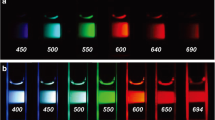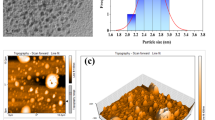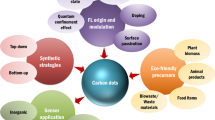Abstract
Carbon dots (CDs) have various applications in biomedical and environmental field, such as bio-imaging, bio-sensing and heavy metal detection. In this study, a novel class of CDs were synthesized using a one-step hydrothermal method. The fabricated CDs displayed stable photoluminescence, good water solubility, and photo stability. Moreover, the functional groups (carboxylic acid moieties and hydroxyls) on the surface of the obtained CDs enable it with superior sensing ability (e.g., very low detectable concentration for Pb2+: 5 nmol/L). With superior detection sensitivity, excellent fluorescent properties and facile fabrication method, the as-obtained CDs can find practical applications as cost-effective and sensitive chemo-sensors in water and food safety field.









Similar content being viewed by others
References
Bao L, Liu C, Zhang ZL, Pang DW (2015) Photoluminescence-tunable carbon nanodots: surface-state energy-gap tuning. Adv Mater 10:1663–1667
Bhunia SK, Saha A, Maity AR, Ray SC, Jana NR (2013) Carbon nanoparticle-based fluorescent bioimaging probes. Sci Rep 3:1473
Bruchez M, Moronne M, Gin P, Weiss S, Alivisatos AP (1998) Semiconductor nanocrystals as fluorescent biological labels. Science 281:2013–2016
Chandra S, Patra P, Pathan SH, Roy S, Mitra S, Layek A, Bhar R, Goswami A (2013) Luminescent S-doped carbon dots: an emergent architecture for multimodal applications. J Mater Chem B 1:2375–2382
Chong Y, Ma Y, Shen H, Tu X, Zhou X, Xu J, Dai J, Fan S, Zhang Z (2014) The in vitro and in vivo toxicity of graphene quantum dots. Biomaterials 35:5041–5048
Chowdhuri AR, Tripathy S, Haldar C, Roy S, Sahu SK (2015) Single step synthesis of carbon dots embedded chitosan nanoparticles for cell imaging and hydrophobic drug delivery. J Mater Chem B 3:9122–9131
Chung W, Jung H, Lee CH, Kim SH (2014) Extremely high color rendering white light from surface passivated carbon dots and Zn-doped AgInS2 nanocrystals. J Mater Chem C 2:4227–4232
Dong YQ (2010) Extraction of electrochemiluminescent oxidized carbon quantum dots from activated carbon. Chem Mater 22:5895–5899
Du Y, Huang S, Wu S et al (2018) Preparation of versatile yolk-shell nanoparticles with a precious metal yolk and a microporous polymer shell for high-performance catalysts and antibacterial agents. Polymer 137:195–200
Fernando KAS, Sahu S, Liu YM, Lewis WK, Guliants EA, Jafariyan A, Wang P, Bunker CE, Sun YP (2015) Carbon quantum dots and applications in photocatalytic energy conversion. ACS Appl Mater Interface 7:8363–8367
Fu M, Ehrat F, Wang Y, Milowska KZ, Reckmeier C, Rogach AL, Stolarczyk JK, Urban AS, Feldmann J (2015) Carbon dots: a unique fluorescent cocktail of polycyclic aromatic hydrocarbons. Nano Lett 15:6030–6035
Ganguly A, Sharma S, Papakonstantinou P, Hamilton J (2011) Probing the thermal deoxygenation of graphene oxide using high-resolution in situ X-ray-based spectroscopies. J Phys Chem C 115:17009–17019
Gao XH, Lu YZ, Zhang RZ, He SJ, Ju J, Liu MM, Li L, Chen W (2015) One-pot synthesis of carbon nanodots for fluorescence turn-on detection of Ag+ based on the Ag+-induced enhancement of fluorescence. J Mater Chem C 3:2302–2309
Gogoi N, Chowdhury D (2014) Novel carbon dot coated alginate beads with superior stability, swelling and pH responsive drug delivery. J Mater Chem B 2:4089–4099
Goncalves H, Jorge PAS, Femrnandes RAJ (2010) Hg(II) sensing based on functionalized carbon dots obtained by direct laser ablation. Sens Actuators B 145:702–707
Gong Z, Karandikar S, Zhang X, Kotipalli V, Lvov Y, Que L (2010) Composite nanomaterial thin film-based biosensors. In: IEEE sensors, pp 29–32
Hu C, Zhai X, Liu L, Zhao Y, Jiang L, Qu L (2013) Spontaneous reduction and assembly of graphene oxide into three-dimensional graphene network on arbitrary conductive substrates. Sci Rep 3:2065
Jiang K, Sun S, Zahng L, Lu Y, Wu A, Cai CZ, Lin HW (2015) Red, green, and blue luminescence by carbon dots: full-color emission tuning and multicolor cellular imaging. Angew Chem Int Ed 18:5360–5363
Jin L, Ren K, Xu QW, Hong TZ, Wu SY, Zhang YL, Wang ZL (2016) multifunctional carbon dots for live cell staining and tissue engineering applications. Polym Compos. https://doi.org/10.1002/pc.23903
Li HT, He XD, Kang ZH, Huang H, Liu Y, Liu JL, Lian SY, Tsang CHA, Yang XB, Lee ST (2010) Water-soluble fluorescent carbon quantum dots and photocatalyst design. Angew Chem Int Ed 122:4532–4536
Li HT, He XD, Liu Y, Huang H, Lian SY, Lee ST, Kang ZH (2011) One-step ultrasonic synthesis of water-soluble carbon nanoparticles with excellent photoluminescent properties. Carbon 49:605–609
Li HT, Kang ZH, Liu Y, Lee ST (2012) Carbon nanodots: synthesis, properties and applications. J Mater Chem 22:24230–24253
Lin X, Liang Y, Lu Z et al (2017) Mechanochemistry: a green, activation-free and top-down strategy to high-surface-area carbon materials. ACS Sustain Chem Eng 10:1021
Liu LQ, Li YF, Zhan L, Liu Y, Huang CZ (2011) One-step synthesis of fluorescent hydroxyls-coated carbon dots with hydrothermal reaction and its application to optical sensing of metal ions. Sci China Chem 54:1342–1347
Liu JH, Cao L, LeCroy GE, Wang P, Meziani MJ, Dong Y, Liu Y, Luo PG, Sun YP (2015) Carbon “quantum” dots for fluorescence labeling of cells. ACS Appl Mater Interface 7:19439–19445
Lvov YM, Pattekari P, Zhang X, Torchilin V (2011) Converting poorly soluble materials into stable aqueous nanocolloids. Langmuir 27(3):1212–1217
Lzumi Y (2013) Recent advances in the photocatalytic conversion of carbon dioxide to fuels with water and/or hydrogen using solar energy and beyond. Coord Chem Rev 257:171–186
Mao LH, Tang WQ, Deng ZY, Liu SS, Wang CF, Chen S (2014) Facile access to white fluorescent carbon dots toward light-emitting devices. Ind Eng Chem Res 53:6417–6425
Mewada A, Pandey S, Thakur M, Jadhav D, Sharon M (2014) Swarming carbon dots for folic acid mediated delivery of doxorubicin and biological imaging. J Mater Chem B 2:698–705
Niu Y, Stadler FJ, He T, Zhang X, Yu Y, Chen S (2017) Smart multifunctional polyurethane microcapsules for the quick release of anticancer drugs in BGC 823 and heLa tumor cells. J Mater Chem B 5:9477
Oza G, Ravichandran M, Shinde S, Mewada A, Ramirez JT, Velumani S, Sharon M, Sharon M (2016) Camphor-mediated synthesis of carbon nanoparticles, graphitic shell encapsulated carbon nanotubes and carbon dots for bioimaging. Sci Rep 6:21286
Pattekari P, Zheng Z, Zhang X, Levchenko T, Torchilin V, Lvov Y (2011) Top-down and bottom-up approaches in production of aqueous nanocolloids of low soluble drug paclitaxel. Phys Chem Chem Phys 13:9014–9019
Qin XY, Lu WB, Asiri AM, Al-Youbi AQ, Sun YP (2013) Green, low-cost synthesis of photoluminescent carbon dots by hydrothermal treatment of willow bark and their application as an effective photocatalyst for fabricating Au nanoparticles-reduced graphene oxide nanocomposites for glucose detection. Catal Sci Technol 3:1027–1035
Schwenke AM, Hoeppener S, Schubert US (2015) Synthesis and modification of carbon nanomaterials utilizing microwave heating. Adv Mater 28:4113–4141
Shen C, Wang J, Cao Y, Lu Y (2015) Facile access to B-doped solid-state fluorescent carbon dots toward light emitting devices and cell imaging agents. J Mater Chem C 3:6668–6675
Su YJ, Xie MM, Lu XN, Wei H, Geng HJ, Yang Z, Zhang YF (2014) Facile synthesis and photoelectric properties of carbon dots with upconversion fluorescence using arc-synthesized carbon by-products. RCS Adv 4:4839–4842
Tan MQ, Zhang L, Tang R, Song X, Li Y, Wu H, Wang Y, Lv G, Liu W, Ma X (2013) Enhanced photoluminescence and characterization of multicolor carbon dots using plant soot as a carbon source. Talanta 115:950–956
Tian Y, Zhang X, Geng H, Yang H, Li C, Da S, Lu X, Wang J, Jia S (2017) Carbon nanotube/polyurethane films with high transparency, low sheet resistance and strong adhesion for antistatic application. RSC Adv 7(83):53018–53024
Vergara D, Bellomo C, Zhang X et al (2012) Lapatinib/paclitaxel polyelectrolyte nanocapsules for overcoming multidrug resistance in ovarian cancer. Nanomed Nanotechnol Biol Med 8:891–899
Vergaro V, Scarlino F, Bellomo C et al (2011) Drug-loaded polyelectrolyte microcapsules for sustained targeting of cancer cells. Adv Drug Deliv Rev 63(9):847–864
Wang F, Pang SP, Wang L, Li Q, Kreiter M, Liu CY (2010) One-step synthesis of highly luminescent carbon dots in noncoordinating solvents. Chem Mater 22:4528–4530
Wang W, Li YM, Cheng L, Cao ZQ, Liu WG (2014) Water-soluble and phosphorus-containing carbon dots with strong green fluorescence for cell labeling. J Mater Chem B 2:46–48
Wang WJ, Hai X, Mao QX, Chen ML, Wang JH (2015) Polyhedral oligomeric silsesquioxane functionalized carbon dots for cell imaging. ACS Appl Mater Interface 7:16609–16616
Xu H, Li Q, Wang LH, He Y, Shi JY, Tang B, Fan CH (2014) Nanoscale optical probes for cellular imaging. Chem Soc Rev 43:2650–2661
Yan FY, Zou Y, Wang M, Mu XL, Yang N, Chen L (2014) Highly photoluminescent carbon dots-based fluorescent chemosensors for sensitive and selective detection of mercury ions and application of imaging in living cells. Sens Actuators B Chem 192:488–495
Yang ST, Gao L, Luo PG, Wang X, Wang H, Meziani MJ, Liu Y, Qi G, Sun YP (2009) Carbon dots for optical imaging in vivo. J Am Chem Soc 131:11308–11309
Zeng HL, Durocher G (1995) Analysis of fluorescence quenching in some antioxidants from nonlinear Stern–Volmer plots. J Lumin 63:75–84
Zhang SR, Wang QG, Tian H, Ge HG (2014) A fluorescent turn-off/on method for detection of Cu2+ and oxalate using carbon dots as fluorescent probes in aqueous solution. Mater Lett 115:233–236
Zheng Z, Zhang X, Carbo D, Clark C, Nathan C, Lvov Y (2010) Sonication assisted synthesis of polyelectrolyte coated curcumin nanoparticles. Langmuir 26(11):7679–7681
Zhou JG, Booker C, Li RY, Zhou XT, Sham T (2007) An electrochemical avenue to blue luminescent nanocrystals from multiwalled carbon nanotubes (MWCNTs). J Am Chem Soc 129:744–745
Acknowledgements
The National Natural Science Foundation of China (Grant nos: 51572303 and 21504082) supports this work. X. Zhang acknowledges the guidance from Prof. Mildred Dresselhaus. L. Jin acknowledges the program of Innovative Talent (in Science and Technology) in University of Henan Province (17HASTIT007).
Author information
Authors and Affiliations
Corresponding authors
Ethics declarations
Conflict of interest
The authors declare no competing financial interest.
Additional information
Publisher’s Note
Springer Nature remains neutral with regard to jurisdictional claims in published maps and institutional affiliations.
Electronic supplementary material
Below is the link to the electronic supplementary material.
Rights and permissions
About this article
Cite this article
Jin, L., Li, J., Liu, L. et al. Facile synthesis of carbon dots with superior sensing ability. Appl Nanosci 8, 1189–1196 (2018). https://doi.org/10.1007/s13204-018-0755-3
Received:
Accepted:
Published:
Issue Date:
DOI: https://doi.org/10.1007/s13204-018-0755-3




